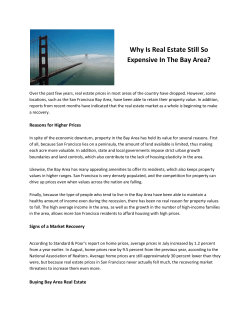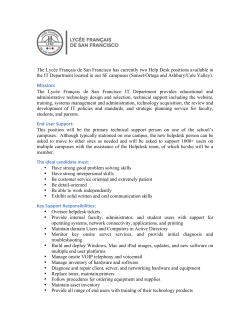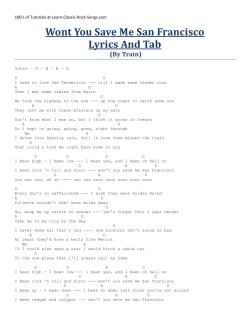
12 Advancing Green Infrastructure for Habitat and Coastal Resilience
AAAS Pacific Division 2015 San Francisco Symposium Abstracts 12 Advancing Green Infrastructure for Habitat and Coastal Resilience The Oro Loma Horizontal Levee Project: Nitrogen Removal in a Constructed Terrestrial-Estuarine Marsh Transition Zone, JEREMY LOWE (San Francisco Estuary Institute, 4911 Central Avenue, Richmond, CA 94804; jeremyl@sfei.org). Over the next century climate change and other drivers in San Francisco Bay, such as sediment and salinity, will create a more dynamic landscape with shifts in location and nature of these habitats. At the same time, nutrient pollution from wastewater effluent threatens to increase the frequency of algal blooms in the Bay, degrading water quality. The Bayland Ecosystem Habitat Goals Update has shown the importance of terrestrial-estuarine marsh transition zones, which once lined much of the Bay, to the future evolution of the Baylands. Seepage wetlands offer an opportunity to restore valuable transition habitat while reducing nutrient inputs to the San Francisco Bay and protecting coastal infrastructure from rising sea-levels. The Oro Loma Horizontal Levee project will test and provide a ‘proof of concept’ for this type of wetland to remove nitrate from wastewater in a seepage wetland that also supports native vegetation and is adaptable to sea level rise. A seepage slope using treated wastewater effluent planted with native species is being constructed to experiment with the restoration of the tidal wetland-upland transition zone. The whole slope acts as a gently sloping platform for sea level rise, that functions hydrologically as a seepage terrace and supports a “wet meadow” (a freshwater slope marsh) dominated by grass-like plants and riparian scrub. The experiments conducted will provide a basis for estimating costs of scaling up these systems and for assessing their potential benefits to the ecosystem. Room to Roam: Softening Shorelines to Accommodate Marsh Transgression as a Strategy to Promote Healthy Tidal Wetlands in the Face of Sea-Level Rise, MICHAEL C. VASEY (San Francisco Bay National Estuarine Research Reserve, Romberg Tiburon Center, San Francisco State University; mvasey@sfsu.edu). Threats of sea-level rise (SLR) to shoreline communities around the San Francisco Estuary (SFE) have driven the development of innovative "green infrastructure" solutions, such as horizontal levees, to protect the shoreline and promote the recovery of tidal and sub-tidal wetland habitats. Yet, the inverse of these engineered solutions involves marsh accommodation to SLR via a timeless natural process known as marsh transgression where - given adequate sediment supply - tidal wetlands move up and inland over gradually increasing topographic boundaries through marsh accretion. This process yields multiple benefits for tidal wetlands including marsh resilience, diverse natural ecotones, tidal refugia for marsh wildlife, and unobstructed hydrodynamic linkage of water, sediment, and organismal movement from terrestrial ecotones to open waters of the estuary. While much of the SFE is dominated by built environments, there are still hundreds of square miles of lowlands surrounding the SFE that are undeveloped and capable of accommodating SLR through marsh transgression - if transportation corridors are modified to allow for marsh connectivity and current land use practices are shifted. Challenges to "shoreline softening" are myriad yet vital to achieving a healthy mixed portfolio of estuarine ecosystems in the future. In this talk, I focus on a pioneering shoreline softening project at China Camp State Park that is still in its early planning stages. What might we learn about future shoreline softening projects in terms of both challenges and opportunities? The goal of this talk will be to plant seeds for future consideration of this important topic. Replenishment of Coarse Estuarine Beaches to Increase Shoreline Resilience: Soft Coastal Engineering Alternatives to Armoring San Francisco Bay, PETER BAYE1* and ROGER LEVENTHAL2 (133660 Annapolis Rd, Annapolis, CA 95412; baye@earthlink.net; 2Marin County Public Works, Flood Control Division, 3501 Civic Center Drive, Suite 304, San Rafael, CA 94903; roger.leventhal@gmail.com). Wave erosion of San Francisco Estuary tidal marshes can result in significant net loss of wetlands. Tidal marsh erosion rates of tidal marshes are expected to increase with accelerated sea level rise, resulting in loss of marsh habitat and wave attenuation functions. Conventional shoreline erosion protection in the region has relied primarily on armoring with rock rip-rap or rubble. We investigated the potential for constructed coarse-grained estuarine beaches to increase shoreline resilience in sensitive wetland habitats of San Francisco Bay by developing a demonstration project on an eroding artificial fill island in San Francisco Bay (Aramburu Island). We investigated existing and historical bay beaches to develop dynamic shoreline designs as an alternative to stabilization of the shoreline in place with armoring. In 2011-2012, we constructed 1,700 linear feet of mixed beach (cobble, gravel, shell and sand). Groin-like log jams were embedded in the shoreline to inhibit longshore drift. The dynamics of the constructed beach included seasonal beachface erosion and post-storm recovery, persistence of cobble berms, slow retreat and coarsening of gravel-shell storm berms, relatively rapid longshore and cross-shore transport of shell and sand, and establishment of new shorebird foraging and breeding habitat. Future applications of this dynamic coarse sediment nourishment design may emulate marsh-fringing barrier beaches to increase horizontal marsh stability as sea level rises, while also providing suitable high tide roost habitats for shorebirds. Constructed mixed coarse beaches may also be an environmentally superior alternative to rip-rap along developed urban shores. Evaluating the Feasibility of Using Dredged Sediment for Tidal Marsh Nourishment to Enhance Shoreline Resiliency to Sea Level Rise and Habitat Enhancement, ROGER LEVENTHAL1* and PETER BAYE2 (1Marin County Public Works, Flood Control Division, 3501 Civic Center Drive, Suite 304, San Rafael, CA 94903; roger.leventhal@gmail.com; 233660 Annapolis Rd, Annapolis, CA 95412; baye@earthlink.net). Natural terrestrial-estuarine marsh transition zones include the transport of watershed derived sediments to maintain the landward edge of estuarine tidal marsh at alluvial fans and deltas. These sediments may include mixed coarser and fine-grained sediments that build and maintain the higher elevation marsh habitats along upper tidal marsh edges as well as groundwater discharge connections (seeps), supporting important ecosystem functions and hot spots of biodiversity. These important dynamic terrestrial-edge estuarine dynamics and processes are often eliminated by urban development resulting in a loss of marsh habitat and loss of wave attenuation and increase in direct coastal flooding impacts. The proposed feasibility study will develop the ecological and engineering opportunities and impacts of using thin-layer hydraulic sediment splay deposition techniques to engineer analogs of this terrestrial-tidal marsh sediment connection along the landward edges of Bothin Marsh, Marin County. Thin sediment layers allowing direct recovery of partially buried vegetation, using mixed fluvial and estuarine dredged sediment will be applied. Direct thin-layer sediment nourishment to high marsh zones contrasts with conventional use of dredged sediment to construct low-mid intertidal marsh platforms in subsided diked baylands. This pilot project is expected to demonstrate the benefits of both high marsh sediment nourishment for wetland habitat enhancement, and flood attenuation, at a location that is highly accessible and visible to the public. The roads and infrastructure currently experience flooding on extreme high tides. Progress in Restoring Native Oysters and Eelgrass for Habitat and Shoreline Protection, KATHARYN BOYER1*, MARILYN LATTA2, CHELA ZABIN3, TED GROSHOLZ3, SUSAN DE LA CRUZ4, and JEREMY LOWE5 (1Romberg Tiburon Center, San Francisco State University, 3150 Paradise Drive, Tiburon, CA 94920, katboyer@sfsu.edu; 2State Coastal Conservancy, 1330 Broadway, Suite 1300, Oakland, CA 94612, marilyn.latta@scc.ca.gov; 3University of California, Davis, cjzabin@ucdavis.edu, tedgrosholz@ucdavis.edu; 4USGS Western Ecological Research Center, San Francisco Bay Estuary Field Station, 505 Azuar Drive Vallejo, CA 94592, sdelacruz@usgs.gov; 5ESA, 550 Kearny Street, Suite 800, San Francisco, CA 94108, JLowe@esassoc.com). Since the 2012 installation of the State Coastal Conservancy’s San Francisco Bay Living Shorelines: Nearshore Linkages Project in San Rafael, CA, we have monitored the large treatment plots (oyster shell reef and eelgrass, both alone and together, versus no added structure) for habitat and shoreline protection functions. Eelgrass has reached >125% of planted densities, and native Olympia oysters recruited early and heavily to the reefs (>2M in first year), especially on north-facing, lower, or vertical surfaces that minimize thermal stress. Many invertebrate species are reproducing on the oyster shell reefs, including native oysters. Trapping with minnow and oval traps has shown an increase in invertebrates preferring physical structure, including bay shrimp and Dungeness crab. Suction sampling, trapping and seining indicate that oyster reef and eelgrass presence together maximize species of fish and invertebrates present compared to each habitat alone. Acoustic monitoring of tagged fish has detected visitation by green and white sturgeon, leopard shark, steelhead, and striped bass. Certain bird groups have increased foraging activity after installation of the project, including Black Oystercatcher and several wading bird species. Wave energy is reduced by 30-50% by the oyster shell reefs beyond what the broad mudflat in this region accomplishes on its own. This project is advancing our understanding of restored habitat functions while examining shoreline protection benefits in an era of rising seas and increasing storm surges.
© Copyright 2025









